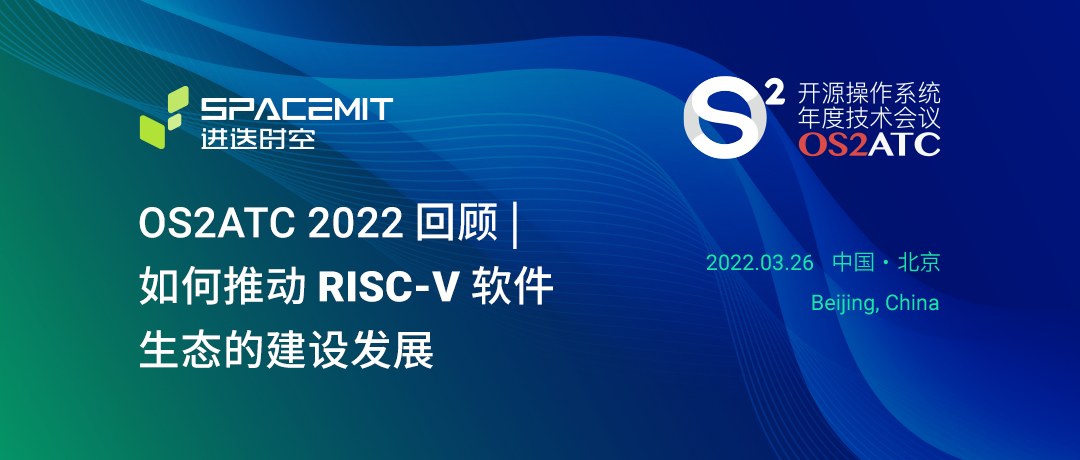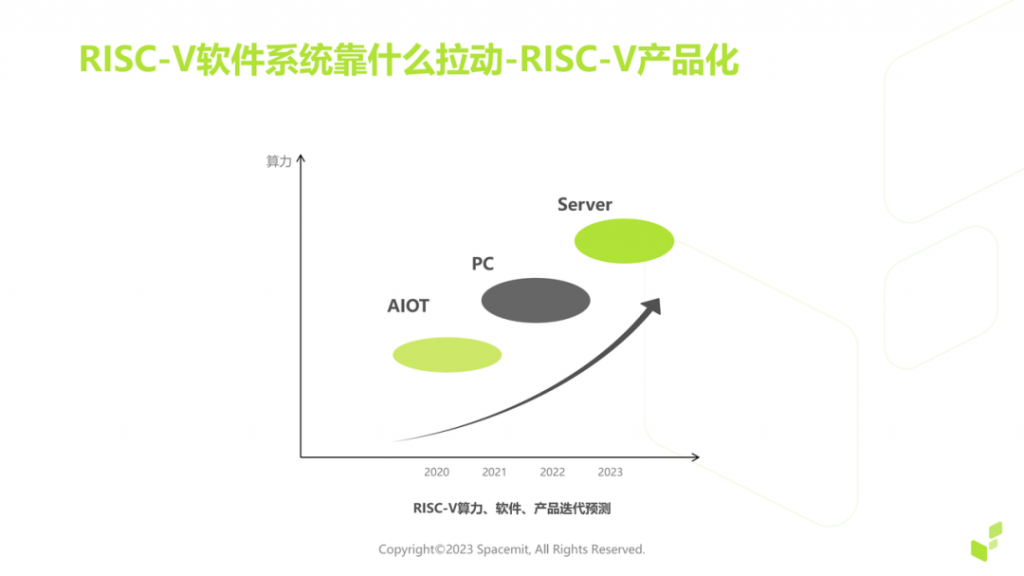
On March 26, the 10th Open Source Operating System Annual Technical Conference (OS2ATC), sponsored by Uniontech and organized by Tsinghua University, Peking University, and Xcalibyte Software, was officially held in Beijing. This conference brings together well-known experts and scholars in domestic operating systems and related fields to discuss the development of hardware, RISC-V architecture, programming technology, AIoT, kernel, cloud-native, virtualization, automotive software, and other fields around “open-source innovation”. Sun Yanbang, the founder and president of SpacemiT, was invited to participate in the meeting and made a sharing on the topic of “The Road to Productization of RISC-V Software System”.

“Compared with the mainstream instruction set ecosystem of the previous generation, the investment in the new generation instruction set software ecosystem is more than 10 times.”
For instruction set architecture, the importance of software ecosystem is self-evident. Sun Yanbang pointed out that taking x86 and ARM as examples, the x86 ecosystem is dominated by the Wintel (Intel + Microsoft) alliance, and this model has built the software ecosystem of the entire PC era. And ARM focuses on making instruction sets, a semi-open model, with dozens of well-known ARM chip companies such as Qualcomm, Samsung, and Texas Instruments, as well as operating system suppliers such as Google, Apple, and Huawei, which allows ARM to combine upstream and downstream to form a camp.

Unlike x86 and ARM, RISC-V is a truly open ecosystem model. All parties, whether engaged in chip design, software development, or EDA debugging tools, can participate in the open model of RISC-V to jointly build an ecosystem.
The Wintel giant alliance has always occupied a dominant position in the PC and server markets, and the ARM camp has dominated the mobile era. Then in what fields will RISC-V be successfully applied in the future, AIoT, PC, or servers? It has not yet been concluded, and RISC-V ecosystem enterprises are still working to explore, pushing RISC-V to a wider and higher-end application field.
At the same time, Sun Yanbang called on everyone to invest in building the RISC-V ecosystem.
In the x86 era, Intel and Microsoft invested tens of thousands of people in the software system ecosystem. Although the ARM company itself has a small number of people, the number of people invested in the software ecosystem of the ARM camp is about hundreds of thousands. For RISC-V, to achieve great success, there must be more personnel investment in the future, and the open model can allow more personnel to participate. Therefore, compared with the mainstream instruction set ecosystem of the previous generation, the investment in the software and hardware ecosystem of the next generation instruction set is more than 10 times.
“The development and maturity of an instruction set ecosystem ultimately need to be driven by productization.”
Sun Yanbang believes that whether it is the x86 or ARM architecture, the key to success is not the performance, but the productization of the architecture in various industries. He further explained: “In the earliest days, x86 was not a winner in performance. At that time, Intel’s chips were also used in various fields such as network equipment and game consoles. x86 has experienced the development process from low performance to high performance, and seized the two major industrial opportunities which are PC and server, and finally succeeded in becoming the mainstream structure globally.
The same goes for the success of the ARM architecture. The earliest computing power of ARM can be traced back to ARM1. Everyone started to get familiar with ARM by ARM7 and ARM9, which are applied to functional phones, etc.; when the Cortex-A series was launched, a real breakthrough was made. Mobile phones entered the era of smartphones, and ARM architecture was widely used and gained a staged growth of technology. Currently, ARM performance has reached the level of the server field. The mainstreaming of x86 and ARM architecture also benefited from productization and achieved the iterative upgrading process of computing power from low to high development.

Talking about the productization of RISC-V, Sun Yanbang said that, unlike x86 and ARM, RISC-V will develop in many fields in the future, and its application fields may include AIoT, PC, server, etc. In addition to the widely used AIoT field, there are also examples like the world’s first RISC-V notebook ROMA released at the venue that day, and the server-level processor SG2042 launched by SOPHGO this year.
Different from Intel and ARM commercial companies, Sun Yanbang emphasized that RISC-V is an open model that can be cut into by different fields at the same time. There may be one or more different commercial companies in one field, so the speed of productization and ecosystem maturity will develop more rapidly.
“An instruction set ecosystem, from the development to maturity, and finally becomes the mainstream globally, in the final analysis, it needs to rely on productization.” Sun Yanbang concluded.
“RISC-V can be built quickly by taking advantage of concurrency.”
Unlike the serial development process of x86 and ARM, RISC-V is a multi-stage concurrent development. Due to the open ecosystem, different organizations such as commercial companies, academic institutions, and universities can participate in the development of RISC-V at the same time, and a series of links such as instruction sets, chip design, software development, and products can also develop in parallel. Therefore, with this unique concurrency advantage and the joint participation of people from different fields, RISC-V can complete the construction more efficiently.

Sun Yanbang also pointed out that although RISC-V is developing rapidly, it still faces three major challenges to become the world’s mainstream instruction set:
First: The maturity of the RISC-V ecosystem is still insufficient. Compared with the two mainstream architectures of x86 and ARM, RISC-V may have fewer software libraries, toolchains, and middleware available.
Second: In the process of software migration, it is necessary to provide better software and hardware compatibility to reduce the loss of performance and power consumption.
Third: If RISC-V enters large-scale and high-computing applications (such as servers) in the future, the support of commercial software is one of the first keys.
Sun Yanbang introduced that as an innovative enterprise in the RISC-V field, SpacemiT focuses on the development of high-performance CPU chips with the next-generation RISC-V architecture. In terms of software, the company mainly makes compilers and debuggers and makes a lot of Linux kernels. In addition, SpacemiT also provide RISC-V hardware devices, development boards, and other supporting software systems. Sun said that the open source and open nature of the RISC-V architecture make it have broad development prospects, and SpacemiT is willing to join hands with all parties in the industry to enrich the RISC-V ecosystem and promote RISC-V to greater success.